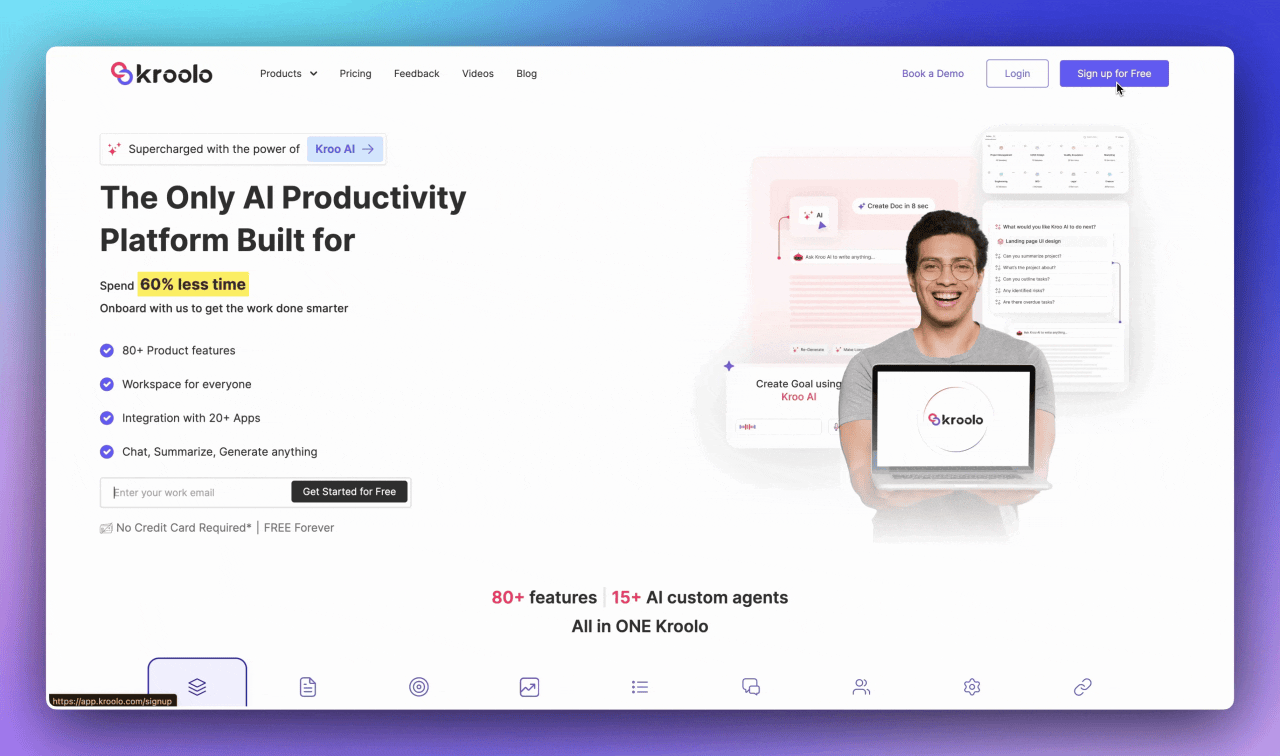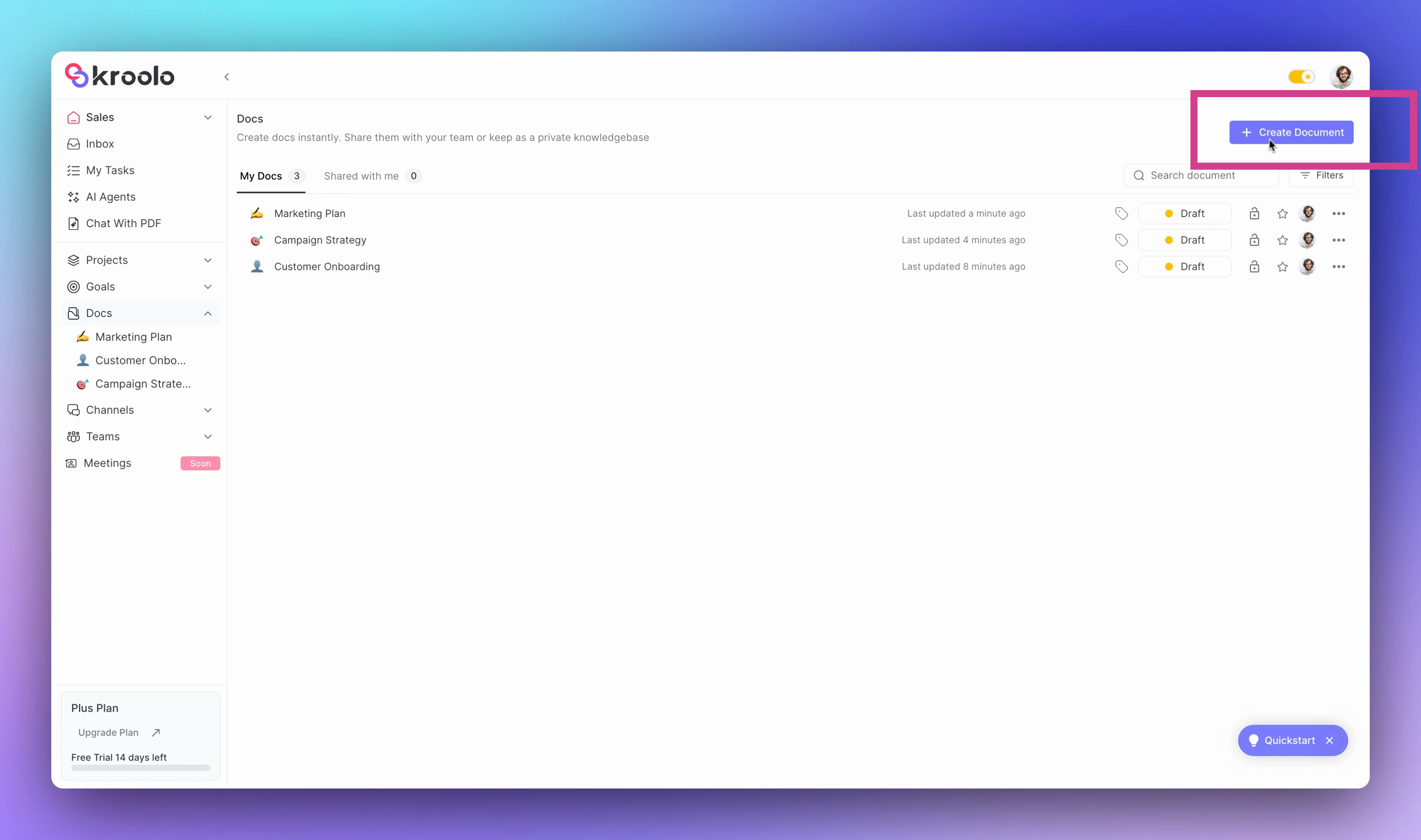


Jul 24, 2025
-
By Julia

![]() AI Summary By Kroolo
AI Summary By Kroolo
Operation management involves overseeing processes that turn resources into products or services. This includes planning, organizing, and controlling production or service delivery to maximize efficiency.
In short, it ensures inputs (materials, labor, energy) are transformed into outputs reliably. The global management market is expected to rise at 10.2% between 2023 to 2030.It is driven by AI augmentation, supply chain automation, and sustainability.
In this guide, we define operation management, explain why it matters, explore use cases with real-world examples, and show how Kroolo enhances operation management.
Operation management focuses on efficient resource utilization and process control. It is concerned with planning, designing, and managing the processes that produce a company’s goods or services. The goal is to use resources optimally, reducing waste and avoiding bottlenecks so every step adds value.
The core concept of operation management is doing more with less. This means designing workflows so that each step contributes to the final output. Key tasks include inventory management, scheduling production, and maintaining quality standards.
For example, managers carefully plan production runs and stock levels to match customer demand. Overall, operation management continuously refines processes to make them faster and more efficient.
Operations apply to both manufacturing and services. In manufacturing, it means overseeing factories and supply chains; in services (like healthcare or banking), it means managing workflows and resources.
Despite the setting, the goal remains the same: deliver quality outputs on time and within budget. Effective operation management balances cost, speed, and quality to meet customer needs in any industry.
Typical activities include process design, quality control, capacity planning, and continuous improvement. For example, an operations team might map out each step of a production process and set quality checkpoints.
They also plan how many machines or staff are needed to meet targets. These activities ensure that day-to-day operations run smoothly and match strategic plans.
An operations manager coordinates these activities. This person collaborates across departments (with supply chain, finance, engineering, etc.) to align resources and goals. In practice, the manager schedules staff, oversees maintenance of equipment, and addresses any bottlenecks. They track performance metrics (like output per hour) and adjust processes to hit targets.
Advanced operation management also covers strategic planning. Teams decide on things like facility expansion or new technology investments ahead of time. Then they execute by allocating resources and tasks. Finally, they monitor outcomes and make improvements. This planning-execution-review cycle (continuous improvement) keeps operations in sync with goals.
Operations is a core business function alongside marketing, finance, and HR. Unlike marketing (customer-facing) or finance (budget-focused), operations focus inward to deliver the product or service.
It must work closely with other functions: for example, operations uses marketing forecasts and finance budgets to plan production. This cross-functional integration ensures the company’s offerings are delivered efficiently.
Effective operation management directly drives a company’s success. It boosts productivity, ensures quality, and keeps costs under control. Companies excelling in operations management often significantly outperform rivals. For instance, McKinsey reports top operators can beat peers by about 20%. In practice, strong operations mean quicker deliveries, lower costs, and happier customers.
Strong operations increase productivity by removing waste and streamlining steps. For example, Toyota’s Just-in-Time system reduces inventory waste by producing only what’s needed. Modern firms also use data analytics to forecast demand, avoiding overproduction or stockouts. Overall, leaner workflows let employees and machines produce more in the same time.
Operation management embeds quality checks into processes. Automated inspections or standard protocols catch defects early. For example, a factory might use sensors to detect faulty items on the line. Over time, this consistency improves outputs and customer trust.
When operations run smoothly, customers get what they expect, when they expect it. Efficient workflows and automation (like AI-powered chatbots) help deliver products quickly and provide 24/7 support. Reliable operations mean fewer delays or mistakes, keeping customers happy and loyal.
Efficient operations cut costs. By eliminating redundant steps and using resources wisely, companies spend less on materials and labor. Lean practices (such as producing on demand) avoid excess inventory. Over time, these savings improve profit margins and financial flexibility.
Good operation management identifies risks early. Predictive maintenance (analyzing sensor data) schedules repairs before breakdowns occur, preventing costly downtime. Flexible operations can also adapt quickly to change: if demand shifts or a supplier issue arises, agile processes allow rerouting production or sourcing alternatives fast.
Operational excellence provides a competitive edge. Companies like Amazon and Tesla set industry standards with continuous process improvement. Leveraging new technologies and refining processes makes these companies faster and leaner than competitors. This ongoing improvement cycle helps them stay ahead.
Operation management practices apply across many scenarios:
A classic use case is managing inventory and supply chains. Operations teams forecast demand and automate reorders just in time. Real-time tracking of items ensures products move efficiently through warehouses. These practices prevent stock-outs and speed delivery to customers.
In supply chain operations, efficient warehouse and inventory management are crucial. Advanced operation management uses real-time tracking and forecasting to keep inventories balanced and goods flowing smoothly through the supply chain. For example, automated reordering ensures popular items are restocked just in time for demand.
Operations decide what and when to produce. In factories, managers schedule production runs so machines and workers are fully utilized. In services, they plan staffing (for example, a hospital schedules nurses based on patient load). Proper planning ensures resources meet demand without excessive idle time.
Operation management includes quality control. For example, products may pass through testing stations to catch defects early. Methodologies like Lean or Six Sigma are applied to refine processes over time. These practices continually reduce errors and improve efficiency.
Operations also cover customer-facing services. For example, call centers use scheduling and routing to answer calls efficiently. Online stores optimize order processing workflows for speed. Companies even use AI chatbots for routine inquiries. In each case, operations processes aim to provide consistent, timely service.
Operations also cover facilities and maintenance. Teams schedule regular equipment upkeep to prevent breakdowns and manage utilities (like energy). For example, a factory might use sensors to monitor machine health and trigger preventive maintenance. Efficient facility management keeps plants running smoothly.
Finally, operation management methods are used in redesigning processes or launching projects. A company might map a workflow end-to-end and eliminate inefficiencies. Streamlining a customer onboarding process could involve removing redundant steps. Applying operations best practices ensures even one-time projects run efficiently.
Leading organizations provide concrete examples of advanced operations:

Tesla and Dell have refined their production operations. Tesla’s Gigafactories use extensive automation and data to scale production efficiently. Dell uses a build-to-order model, assembling computers only after orders arrive, which minimizes inventory. These examples show how tight process control saves costs and improves responsiveness.
Amazon and Walmart excel in supply chain operations. Amazon’s warehouses use robots and optimized logistics to process orders rapidly. Walmart uses real-time inventory tracking so stores automatically replenish stock. These systems keep shelves stocked and customers satisfied.
In healthcare, operation management improves patient care. For example, Cleveland Clinic uses data analytics and AI to optimize patient flow and staffing. This reduces wait times and ensures critical resources (like ICU beds) are available when needed. Hospitals also apply Lean methods to speed up procedures and reduce errors, enhancing service quality.
Marriott International demonstrates operations in hospitality. Marriott standardizes procedures (like check-in and housekeeping) across hotels. It coordinates deliveries and training worldwide. These operational standards ensure guests receive a reliable experience.
Tech companies emphasize streamlined operations. Google uses Site Reliability Engineering (SRE) to automate data center management. Its teams use DevOps to deploy updates without downtime. Cloud services rely on automated workflows for server scaling. These practices ensure digital services stay available at scale.
Even finance firms leverage operation management. JPMorgan Chase uses AI and analytics to automate tasks like fraud detection and compliance checks. It also employs robotic process automation for routine processes. Behind every digital transaction is an operational workflow designed for security and speed. These examples show that robust operations are critical in every industry.
Implementing strong operation management yields many advantages:
Streamlined operations enable higher output with the same inputs. By eliminating unnecessary steps and optimizing workflows, companies can significantly boost productivity. For instance, automating routine tasks frees employees to focus on higher-value work. Well-designed processes mean each part of the organization operates at peak efficiency.
Standardized operations yield consistent results. When every product or service follows a controlled procedure, errors drop. Automated checks or strict protocols catch issues early. Over time, this builds customer trust and reduces costs associated with defects or rework.
Efficient operations cut costs by minimizing waste of materials, time, and labor. Lean process design (for example, producing on demand) means less spending on excess inventory. These savings improve profit margins. In other words, operation management helps a business do more with less.
Modern operations gather data at every step. Dashboards highlight key metrics (like throughput or downtime) so managers can spot problems instantly. For example, if a production line slows, the system alerts supervisors to take action. This data-driven approach helps keep operations aligned with real conditions.
Reliable operations mean customers receive products and support on time, increasing satisfaction. Efficient order fulfillment and responsive support maintain loyalty. For example, 24/7 AI chatbots ensure inquiries are answered quickly. Consistent service quality over time leads to repeat business and referrals.
Efficient operations also foster innovation. As teams adopt new methods and technologies, they discover smarter ways to work. Feedough notes that operation management plays a crucial role in innovation and competitiveness. Companies that continuously refine their processes stay ahead of the competition.
Today’s advanced operation management uses modern techniques:
Lean and Six Sigma methods help eliminate waste and defects. Teams map processes to find inefficiencies and then remove them. This ongoing refinement makes operations simpler and more reliable.
AI and machine learning are transforming operations. AI models predict demand and maintenance needs, making planning smarter. For example, AI can reduce sales forecasting errors by up to 50%. These tools enable operations to become proactive rather than reactive.
IoT devices provide real-time data from equipment and products. Automated systems use this data to adjust processes on the fly. For instance, sensors might detect a machine issue and trigger a repair workflow automatically. This connectivity reduces manual checks and keeps operations running smoothly.
Predictive analytics uses historical and current data to guide decisions. Operations teams analyze past performance and trends to forecast future needs. These insights allow managers to allocate resources ahead of time. Decision-support dashboards then guide adjustments to keep operations on track.
Cloud-based platforms and collaborative tools improve operations. ERP systems unify inventory, HR, and finance data. Work management tools (like Kroolo) integrate project planning and communication. This integration ensures everyone works with the same data and plans together in real time.
Agile and continuous improvement techniques keep operations adaptive. Teams implement changes in short cycles and review results frequently. Quick iterations and feedback loops mean operations processes evolve steadily, helping organizations respond rapidly to new challenges.
Kroolo is an AI-powered WorkOS that streamlines operations through AI and unified tools:

Kroolo automates routine tasks across business and IT operations. Workflows like IT support tickets or approvals run automatically with AI assistance. For example, an incoming help request can be routed and resolved through Kroolo without manual handoffs. This reduces errors and lets employees focus on strategic work.
Kroolo provides real-time analytics dashboards. Managers see live updates on project status, resource use, and timelines. If a task falls behind, the dashboard highlights it immediately. This visibility helps teams identify bottlenecks and keep projects on schedule.
Kroolo’s dashboard and analytics features provide real-time insights into key operational metrics, enabling teams to identify bottlenecks and optimize productivity. By visualizing data on completion rates, resource use, and timelines, Kroolo empowers managers to make informed decisions quickly. For example, if a production line falls behind schedule, the dashboard highlights it instantly, prompting managers to reallocate resources as needed.

Kroolo’s AI can generate operational documents on demand. For instance, a manager can prompt Kroolo to draft a new process outline. The platform also lets users upload SOPs or manuals and then query them in plain language. This makes it easy to create, organize, and retrieve critical knowledge when running operations.
Kroolo includes AI agents that provide around-the-clock support. These virtual assistants can answer routine customer or internal inquiries at any time. For example, after hours a chatbot can resolve common issues automatically. This ensures continuous help and maintains high service standards even outside normal hours.
Kroolo’s AI-driven support offers round-the-clock customer service and internal help desk functionality. Its AI agents can resolve common inquiries and escalate issues seamlessly, leading to higher customer and employee satisfaction. For instance, if a customer raises a question at midnight, the AI assistant can address it immediately without waiting for human staff.

Kroolo consolidates communication and tasks in one workspace. Teams can chat, share files, and track tasks together. For example, a discussion about a project in Kroolo Docs can directly link to related tasks on the project board. This unified setup keeps everyone informed and aligned on operational work.
Kroolo covers the full operations lifecycle. Teams use it for planning, execution, and monitoring. For instance, after defining goals in Kroolo Docs (planning), tasks are managed on boards (execution) and results are analyzed on dashboards (monitoring). This end-to-end support keeps operations cohesive.
Tags
Project Management
Productivity